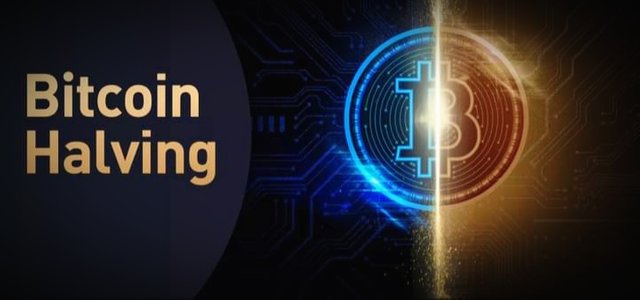Bitcoin Halving, Bitcoin Pump Event and Crypto.

Bitcoin Halving, Bitcoin Pump Event and Crypto.
Lots of questions about the Bitcoin Halving. What is Halving?
What is the impact on the market and why is the Bitcoin Halving widely used as an indicator by Bitcoin traders, miners, and traders to take positions?
This time I will review thoroughly about Bitcoin Halving, so what is Bitcoin halving?
Bitcoin halving is an event when the reward for Bitcoin miners is reduced, if there is a term mining or miner, it doesn't mean we go to the mountain with an ax and keep hitting rocks like mining people imagine.
But mining in the context of Bitcoin means conducting transaction validation activities and when successfully validating the transaction, the miners get a reward in the form of Bitcoin.
Bitcoin miners validate transactions by solving a complex puzzle that requires adequate computer equipment. Bitcoin halving is an event when the miners' rewards are reduced by half, usually this happens every four years or every 210 thousand blocks.
The first Bitcoin halving started on November 28, 2012 from the reward of 50 BTC reduced to 25 Bitcoin only, the second Bitcoin Halving occurred on July 9, 2016, the block reward decreased to 12.5 Bitcoin. The third Bitcoin helving occurred on March 11, 2020, the block reward was only 6.25 BTC.
Although the block reward drops by half every four years, but the Bitcoin price has gone up thousands of percent, the next Bitcoin halving is expected to occur in 2024.
Could the Bitcoin halving be accelerated due to better computer technology?
Yes, the logic is that, if we use better technology for mining, the mining process can be faster. For example, if it used to be 4 years, now it might take a year, because the computer is faster.
That's the logic, but sadly it's not that easy, that's not how it works. So Satoshi Nakamoto has arranged it in such a way to make the puzzle more difficult, if we use a faster computer, the Bitcoin protocol algorithm can automatically make adjustments to make or simplify a puzzle by looking at the history of the miners' activities for the past two weeks.
So circumventing this system cannot, this is because it has been arranged by Satoshi Nakamoto. The average time it takes to validate 1 Bitcoin block is 10 minutes, if the miners finish it faster the next they will get a more complicated algorithm to solve.
So the time to validate 1 Bitcoin Block remains 10 minutes. As fast and sophisticated as any computer used and 210 thousand blocks is expected to be achieved in approximately four years.
What is the impact of this Bitcoin halving?
The Bitcoin halving reduces the number of new coins produced and reduces the supply. This has a direct impact on the price skyrocketing before or after the halving, the price of Bitcoin during the first halving was at 16 dollars, then to 258 dollars in April 2013 and reached 1,163 dollars in November before finally falling to 390 dollars in December.
Followed by Crypto Winter until 2015 and even touched 200 dollars in 2015, at the second Bitcoin halving in 2016 the price has crept up since January 2015 to 775 dollars. Then it continued with a bullish run until December 2017 and touched 19 thousand, after which Bitcoin crashed again and continued its bearish period until 2018 which touched a low of 3,270 dollars.
After that, it was continued by crypto winter, those who don't understand what Crypto winter is can browse to find the most complete information. Crypto winter lasts until the third halving, which is May 2020. After that Bitcoin has a bullish run again until May 2021, before finally crashing again.
So, before the Bitcoin halving, the price of Bitcoin always went up..?
The answer is not necessarily. Indeed, in the 2013 and 2016 halvings Bitcoin rose before the halving, but not in 2020, the Bitcoin price skyrocketed a few months after the halving.
Does Bitcoin price always crash after the Bitcoin halving?
The answer is the same, not necessarily. But if asked whether the price will skyrocket near the halving period? The answer is Yes. Approaching the halving, the price of Bitcoin is like a roller coaster, but in my personal opinion, the answer is, in my personal opinion, yes.
This Bitcoin halving event is not as big as other events, for example events such as Bitcoin ETF and global addoption, the important thing is global addoption. There are companies or countries that use Bitcoin as treasuries or are considered legal tender.
What if there are no more Bitcoins to mine?
Bitcoin halving is expected to stop around February 2140, if until 2140 none of us will experience this. If Bitcoin is mined out, it means we have You can only earn Bitcoins from work and get paid with Bitcoins or buy them from people who already have Bitcoins.
So, will the miners close their stalls?
If the miners close the stall, who will verify the transaction? If the miner closes the stall, I don't think so.
This is because the Block reward is only a gift or a reward for taking part in maintaining the blockchain ecosystem. Miners not only earn from Block rewards but also from transaction fees. The more people who use Bitcoin, the more transactions that have to be verified.
The more transactions that must be verified, the greater the transaction fee will be. Bitcoin transaction fees fluctuate. When this post was made, the transaction fee was only three dollars per transaction, a far cry from April's 62 dollars per transaction. But this transaction fee can be tricked by using the Lightning Network or wrapped BTC.